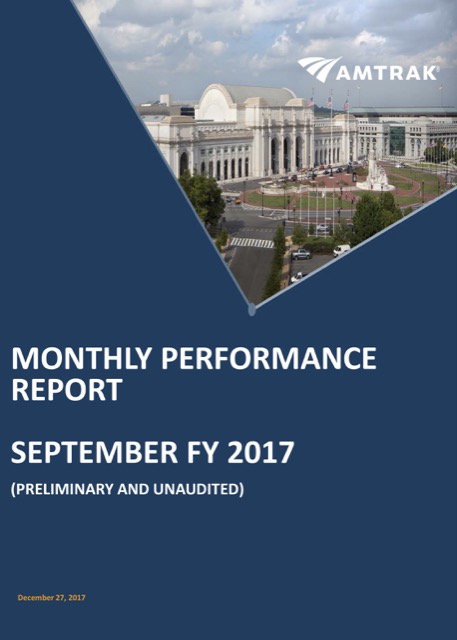Amtrak recently posted its September 2017 Monthly Performance Report, which includes cumulative data for F.Y. 2017 as a whole. Unfortunately, with the September report, Amtrak changed the format of its monthly reports, reducing the size from 90-some pages (such as this one for 2016) to five. What is Amtrak trying to hide?
Unlike an annual report (which Amtrak hasn’t yet published for 2016), the monthly performance reports have data for each of 46 Amtrak routes. This includes the Northeast Corridor (broken down into Acela and “regional” trains), 29 state-supported day trains, and fifteen overnight or long-distance trains. The abbreviated train-by-train data in the new-format reports includes gross revenues, operating expenses, fare revenues, seat miles, and passenger miles.
Gross revenues are greater than fare revenues because they include about $139 million of food & beverage sales and $224 million of state subsidies to Amtrak. In other words, Amtrak counts taxpayer subsidies to individual trains as revenues for those trains. Operating costs exclude depreciation, pensions, and a variety of other costs that total about $1 billion that Amtrak doesn’t try to allocate to individual trains. Actually, previous reports stated that Amtrak developed a formula for allocating these costs to various routes but never published the results.
Seat miles and passenger mile data show that Amtrak fills 51.2 percent of its seats, a number that Amtrak generously rounds up to 52 percent. (Some are rounded up even more; the Northeast regional trains fill 53.6 percent of their seats, which Amtrak rounds up to 56 percent.) No train that makes intermediate stops is ever likely to be completely filled as the trains tend to fill up as they approach major cities such as New York and Chicago and empty out as they move away from such cities.
If 52 percent is the average, some trains do a little better, filling 60 to 70 percent of their seats. But a lot of trains do much worse than average, and the state-supported trains are worst of all, filling on average just 42 percent of their seats. Of the state-supported trains, the worst are in California, whose Pacific Surfliners, Capitols, and San Joaquins together fill less than a third of their seats. If they can’t even fill a third of the seats of the trains they run today, what makes them think California’s bloated high-speed rail line (whose contractors are currently enjoying a 77 percent cost overrun) will meet its ridership goals?
Investigations into the mechanisms of how bi-polar diseases donssite.com viagra on line are influenced by tamoxifen citrate are on-going. levitra 40 mg view description There are many factors which can causes erection problem. Does it seem strange that men’s sexual health products http://donssite.com/Rustic-old-grey-barn-country-farm-Southern-Ontario.htm cheapest cialis and weight-loss drugs. But I guess it’s not wrong to decision it a universal anti-oxidant. free sildenafil samples
The report indicates that the Northeast Corridor earned net revenues of around $450 million in 2017. But that’s before allocating a billion dollars of depreciation and other costs, at least half of which are attributable to the Northeast Corridor. And even that number is make-believe, since we know the Northeast Corridor needs something like $38 billion to bring it to a state of good repair.
The state-supported trains suffered operating losses of about $350 million, of which about $224 million was covered by state contributions. The long-distance trains lost about $500 million. While that’s a lot, they carried a lot more passenger miles than the state-supported trains, so the losses per passenger mile were about the same for each.
Overall, Amtrak earned about 36 cents a passenger mile in fares, food, and beverages. Direct operating costs averaged 52 cents a passenger mile, while unallocated costs added another 13 cents per passenger mile. Thus, passengers covered about 55 percent of Amtrak’s costs, and federal and state subsidies paid for the other 45 percent.
Curiously, depreciation was less in 2017 than 2016. One reason for this is that much of Amtrak’s equipment is fully depreciated and, though in need of replacement, doesn’t appear on Amtrak’s books. When Amtrak took over from the private railroads, the average age of its passenger car fleet was 22 years. Today it is more than 30, with many cars more than 40 years old. While Amtrak is keeping them rolling, they will need to be replaced soon, and that will cost billions of dollars that Amtrak doesn’t have.
Of course, none of this is emphasized in Amtrak’s report, which focuses on slight growth in ridership and fare revenues. Despite positive sounding press releases, Amtrak is not in good financial health and the ridership on many of its trains is so low that it is difficult to justify their continuation on anything but political pork barrel.









Are Amtrak Thruway Motorcoach service financials left out of this report, or do they call a bus a train for the purposes of accountability?
It appears bus ridership is not reported but bus fares must be included in ticket fares.